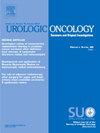Gene expression of prostate-specific membrane antigen (FOLH1) in clear cell renal cell carcinoma predicts angiogenesis and response to tyrosine kinase inhibitors
IF 2.4
3区 医学
Q3 ONCOLOGY
Urologic Oncology-seminars and Original Investigations
Pub Date : 2025-03-01
DOI:10.1016/j.urolonc.2024.10.013
引用次数: 0
Abstract
Purpose
Combination systemic therapies (CSTs) of immuno-oncologic (IO) and VEGF-inhibiting agents (VEGFi) have become the standard of care for management of metastatic clear cell renal cell carcinoma (m-ccRCC). However, treatment outcomes vary between patients, with no established biomarkers to determine optimal CST regimens (IO/IO or IO/VEGFi). Prostate Specific Membrane Antigen (PSMA), encoded by the FOLH1 gene, is a marker of tumor neovasculature in ccRCC, the downstream target of VEGFi. We evaluated the relation between FOLH1 expression and angiogenesis, as well as clinical outcomes, in 5 m-ccRCC ST trials.
Materials and Methods
using Spearman's rank correlation (SPRC) test, we assessed the correlation between FOLH1 expression and gene expression signature (GES) scores corresponding to angiogenic and immunologic features of the tumor microenvironment (TME) of m-ccRCC in our trial cohorts. Using Cox proportional hazard regression (Cox-PHR), we assessed the association between FOLH1 expression level, summarized by within-study quantiles (qFOLH1), and progression-free and overall survival (PFS, OS).
Results
Increased FOLH1 expression was significantly associated with higher TME angiogenesis GES scores (SPRC +0.5, P < 0.001), but did not consistently correlate with immune feature GES scores. Meta-analysis of PFS in the sunitinib TKI arm of trial cohorts showed an overall positive association with qFOLH1 (HR = 0.89; 95% CI = 0.85-0.94, P < 0.0001). qFOLH1 was not significantly associated with OS in the sunitinib arms of the two trials with OS data (COMPARZ, HR 0.87, 95% CI 0.71–1.07, P = 0.17; and Checkmate-214, HR 0.89, 95% CI 0.67–1.17, P = 0.70).
Conclusions
PSMA-encoding FOLH1 gene expression correlates with neoangiogenesis and predicts PFS in m-ccRCC patients treated with sunitinib TKI, suggesting that PSMA PET could be explored as a noninvasive biomarker for guiding CST choice (IO/IO or IO/VEGFi) as well as prediction of treatment response to VEGFi in m-ccRCC patients.
透明细胞肾细胞癌中前列腺特异性膜抗原(FOLH1)的基因表达可预测血管生成和对酪氨酸激酶抑制剂的反应。
目的:免疫肿瘤疗法(IO)和血管内皮生长因子抑制剂(VEGFi)的联合系统疗法(CST)已成为治疗转移性透明细胞肾细胞癌(m-ccRCC)的标准疗法。然而,不同患者的治疗效果各不相同,也没有确定最佳 CST 方案(IO/IO 或 IO/VEGFi)的生物标志物。由 FOLH1 基因编码的前列腺特异性膜抗原(PSMA)是 ccRCC 中肿瘤新生血管的标志物,也是 VEGFi 的下游靶点。我们评估了 5 项 m-ccRCC ST 试验中 FOLH1 表达与血管生成以及临床结果之间的关系。材料与方法:我们使用斯皮尔曼秩相关(SPRC)检验评估了试验队列中 FOLH1 表达与与 m-ccRCC 肿瘤微环境(TME)血管生成和免疫学特征相对应的基因表达特征(GES)评分之间的相关性。我们使用Cox比例危险回归(Cox-PHR)评估了FOLH1表达水平(按研究内定量(qFOLH1)总结)与无进展生存期和总生存期(PFS、OS)之间的关系:结果:FOLH1表达水平的升高与TME血管生成GES评分的升高显著相关(SPRC +0.5,P <0.001),但与免疫特征GES评分的相关性并不一致。对试验队列中舒尼替尼 TKI 治疗组的 PFS 进行的 Meta 分析表明,qFOLH1 与 PFS 呈总体正相关(HR = 0.89;95% CI = 0.85-0.94,P < 0.0001)。在两项有OS数据的试验中,qFOLH1与舒尼替尼臂的OS无明显相关性(COMPARZ,HR 0.87,95% CI 0.71-1.07,P = 0.17;Checkmate-214,HR 0.89,95% CI 0.67-1.17,P = 0.70):结论:PSMA编码的FOLH1基因表达与新血管生成相关,并能预测接受舒尼替尼TKI治疗的m-ccRCC患者的PFS,这表明PSMA PET可作为一种无创生物标志物,用于指导m-ccRCC患者的CST选择(IO/IO或IO/VEGFi)以及预测VEGFi的治疗反应。
本文章由计算机程序翻译,如有差异,请以英文原文为准。
求助全文
约1分钟内获得全文
求助全文
来源期刊
CiteScore
4.80
自引率
3.70%
发文量
297
审稿时长
7.6 weeks
期刊介绍:
Urologic Oncology: Seminars and Original Investigations is the official journal of the Society of Urologic Oncology. The journal publishes practical, timely, and relevant clinical and basic science research articles which address any aspect of urologic oncology. Each issue comprises original research, news and topics, survey articles providing short commentaries on other important articles in the urologic oncology literature, and reviews including an in-depth Seminar examining a specific clinical dilemma. The journal periodically publishes supplement issues devoted to areas of current interest to the urologic oncology community. Articles published are of interest to researchers and the clinicians involved in the practice of urologic oncology including urologists, oncologists, and radiologists.

 求助内容:
求助内容: 应助结果提醒方式:
应助结果提醒方式:


